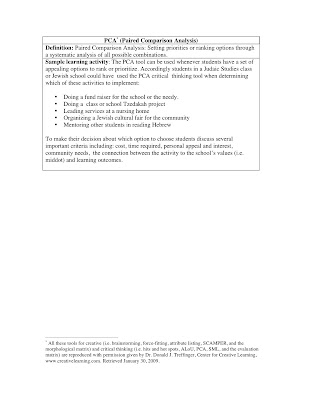
When mentoring our pre-service and in-service teachers we need to describe and model both research-based and clinically tested best practices, and demonstrate how these best practices can be applied in the real (i.e. physical) and virtual (online) classroom for both teaching and teacher training, The combination of face to face instruction in a physical setting and online learning is called blended learning. In this section of the blog we will describe how the internet can serve as a supplemental resource for instruction and the mentoring of pre-service and in-service Jewish educators. In this post we will discuss how the critical thinking tool, Paired Comparison Analysis (PCA) can be used in a Judaic Studies blended learning classroom. This is the first part of a two-part post. The second part of this lesson plan idea follows.
Assumption: The teacher or mentor teacher has a interactive white board (i.e. SMART Board, Promethean, etc.), a Tablet PC (also called a Slate or Blade), a computer presenter or computer with internet access attached to an LCD projector in the classroom. It would be ideal if students or mentees had access to their own laptop computers as well.
Note: Although this lesson plan idea is designed for the Judaic Studies classroom, it can be also be used for training pre-service and in-service Jewish educators for professional or staff development. It is our hope that Jewish educators around the globe will form an online community of practice, a CoP, a group of people who share an interest, a craft, and/or a profession, to enhance the delivery of instruction and training of Jewish educators.
Note: Any of these collaborative writing web 2.0 tools can be used with this lesson plan idea.
- http://primarypad.com/
- http://meetingwords.com/
- http://www.cynapse.com/syncin
- http://ietherpad.com/
- http://titanpad.com/
- http://typewith.me/
- http://meetingwords.com/
Step Four: The students/mentees work in small groups online in the physical or the virtual classroom utilize the PCA critical thinking tool for the options listed on the application examples listed at the top of this post.
Note: This activity can also be used as a face to face classroom learning activity without adding the online component.
Step Five: When the task is completed each group emails its finished product to the teacher/mentor and the members of the class, or posts it on the school’s website.
On the next post we will explore another critical thinking problem solving tool, Sequencing SML (Short, Medium and Long Term).
No comments:
Post a Comment